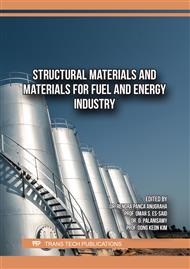[1]
Prayogo, G. S.; Lusi, N. Application of Taguchi Technique Coupled with Grey Relational Analysis for Multiple Performance Characteristics Optimization of EDM Parameters on ST 42 Steel. In AIP Conference Proceedings; Author(s), 2016.
DOI: 10.1063/1.4945515
Google Scholar
[2]
Roy, S.; Kumar, R.; Anurag; Panda, A.; Das, R. K. A Brief Review on Machining of Inconel 718. Mater. Today 2018, 5 (9), 18664–18673.
DOI: 10.1016/j.matpr.2018.06.212
Google Scholar
[3]
Abhilash, P. M.; Chakradhar, D. Prediction and Analysis of Process Failures by ANN Classification during Wire-EDM of Inconel 718. Adv. Manuf. 2020, 8 (4), 519–536.
DOI: 10.1007/s40436-020-00327-w
Google Scholar
[4]
Jadam, T.; Sahu, S. K.; Datta, S.; Masanta, M. EDM Performance of Inconel 718 Superalloy: Application of Multi-Walled Carbon Nanotube (MWCNT) Added Dielectric Media. J. Braz. Soc. Mech. Sci. Eng. 2019, 41 (8).
DOI: 10.1007/s40430-019-1813-9
Google Scholar
[5]
Singh, A.; Ghadai, R. K.; Kalita, K.; Chatterjee, P.; Pamučar, D. Edm Process Parameter Optimization for Efficient Machining of Inconel-718. Facta Univ. Ser. Mech. Eng. 2020, 18 (3), 473.
DOI: 10.22190/fume200406035s
Google Scholar
[6]
Ho, K. H.; Newman, S. T. State of the Art Electrical Discharge Machining (EDM). Int. J. Mach. Tools Manuf. 2003, 43 (13), 1287–1300.
DOI: 10.1016/s0890-6955(03)00162-7
Google Scholar
[7]
Nguyen, H.-P.; Ngo, N.-V.; Nguyen, Q.-T. Optimizing Process Parameters in Edm Using Low Frequency Vibration for Material Removal Rate and Surface Roughness. J. King Saud Univ. - Eng. Sci. 2021, 33 (4), 284–291.
DOI: 10.1016/j.jksues.2020.05.002
Google Scholar
[8]
Kliuev, M.; Florio, K.; Akbari, M.; Wegener, K. Influence of Energy Fraction in EDM Drilling of Inconel 718 by Statistical Analysis and Finite Element Crater-Modelling. J. Manuf. Process. 2019, 40, 84–93.
DOI: 10.1016/j.jmapro.2019.03.002
Google Scholar
[9]
El-Hofy, H. A. Advanced Machining Processes; McGraw-Hill Education, 2005.
Google Scholar
[10]
Li, X. K.; Yan, F. H.; Ma, J.; Chen, Z. Z.; Wen, X. Y.; Cao, Y. RBF and NSGA-II Based EDM Process Parameters Optimization with Multiple Constraints. Math. Biosci. Eng. 2019, 16 (5), 5788–5803.
DOI: 10.3934/mbe.2019289
Google Scholar
[11]
Buschaiah, K.; JagadeeswaraRao, M.; Krishnaiah, A. Investigation on the Influence of Edm Parameters on Machining Characteristics for Aisi 304. Mater. Today 2018, 5 (2), 3648–3656.
DOI: 10.1016/j.matpr.2017.11.615
Google Scholar
[12]
Palanisamy, D.; Devaraju, A.; Manikandan, N.; Balasubramanian, K.; Arulkirubakaran, D. Experimental Investigation and Optimization of Process Parameters in EDM of Aluminium Metal Matrix Composites. Mater. Today 2020, 22, 525–530.
DOI: 10.1016/j.matpr.2019.08.145
Google Scholar
[13]
Caiazzo, F.; Cuccaro, L.; Fierro, I.; Petrone, G.; Alfieri, V. Electrical Discharge Machining of René 108 DS Nickel Superalloy for Aerospace Turbine Blades. Procedia CIRP 2015, 33, 382–387.
DOI: 10.1016/j.procir.2015.06.086
Google Scholar
[14]
Manikandan, N.; Thejasree, P.; Raju, R.; Palanisamy, D.; Varaprasad, K. C.; Sagai Francis Britto, A.; Deeraj Chengalva Sai, A. Investigations on Wire Electrical Discharge Machining of Titanium Alloys by Taguchi—Grey Approach. In Lecture Notes in Mechanical Engineering; Springer Nature Singapore: Singapore, 2022; p.359–368.
DOI: 10.1007/978-981-19-0244-4_35
Google Scholar
[15]
Liu, S.; Liu, Y. An Introduction to Grey Systems: Foundations, Methodology, and Applications; Iigss Academic Publisher, 1998.
Google Scholar
[16]
Manikandan, N.; Varaprasad, K. C.; Thejasree, P.; Palanisamy, D.; Arulkirubakaran, D.; Raju, R.; Badrinath, K. Prediction of Performance Measures Using Multiple Regression Analysis for Wire Electrical Discharge Machining of Titanium Alloy. In Lecture Notes in Mechanical Engineering; Springer Nature Singapore: Singapore, 2022; p.601–612.
DOI: 10.1007/978-981-19-0244-4_57
Google Scholar
[17]
Palanisamy, D.; Senthil, P. Optimization on Turning Parameters of 15-5PH Stainless Steel Using Taguchi Based Grey Approach and Topsis. Arch. Mech. Eng. 2016, 63 (3), 397–412.
DOI: 10.1515/meceng-2016-0023
Google Scholar
[18]
Srinivasan, D., N. Ganesh, H. Ramakrishnan, R. Balasundaram, R. Sanjeevi, and Mohanraj Chandran. "Investigation of surface roughness and material removal rate of WEDM of SS304 using ANOVA and regression models." Surface Topography: Metrology and Properties 10, no. 2 (2022): 025014.
DOI: 10.1088/2051-672x/ac6c9e
Google Scholar
[19]
Majumder, H., and K. P. Maity. "Predictive analysis on responses in WEDM of titanium grade 6 using general regression neural network (GRNN) and multiple regression analysis (MRA)." Silicon 10 (2018): 1763-1776.
DOI: 10.1007/s12633-017-9667-1
Google Scholar
[20]
Sadeghi, Mohammad, Hamideh Razavi, Amin Esmaeilzadeh, and Farhad Kolahan. "Optimization of cutting conditions in WEDM process using regression modelling and Tabu-search algorithm." Proceedings of the Institution of Mechanical Engineers, Part B: Journal of Engineering Manufacture 225, no. 10 (2011): 1825-1834.
DOI: 10.1177/0954405411406639
Google Scholar
[21]
Kulekci, Mustafa Kemal, Adnan Akkurt, Ugur Esme, and Iskender Ozkul. "Multiple regression modeling and prediction of the surface roughness in the WEDM process." Materiali in tehnologije 48 (2014): 9-14.
Google Scholar
[22]
Kumar, Harmesh, Alakesh Manna, and Rajesh Kumar. "Modeling of process parameters for surface roughness and analysis of machined surface in WEDM of Al/SiC-MMC." Transactions of the Indian Institute of Metals 71 (2018): 231-244.
DOI: 10.1007/s12666-017-1159-x
Google Scholar
[23]
Nain, Somvir Singh, Dixit Garg, and Sanjeev Kumar. "Investigation for obtaining the optimal solution for improving the performance of WEDM of super alloy Udimet-L605 using particle swarm optimization." Engineering science and technology, an international journal 21, no. 2 (2018): 261-273.
DOI: 10.1016/j.jestch.2018.03.005
Google Scholar


